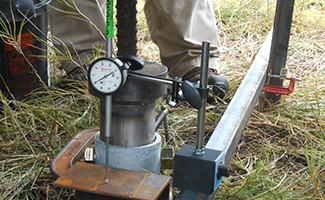
Transmission Tower Foundations
Two high-voltage transmission towers

Problem:
In 2014, Instituto Costarricense de Electricidad (ICE) was building a 230-kV transmission line when it faced a problem. While most of the line’s 75 km path passed through areas with decent soil and no governmental limitations on construction, the last section had to cross an environmentally protected area. Since ICE was not permitted to cut any trees, the only solution was to build two, tall towers (one on each side) 800 meters apart and run the line over the protected area.
Poor soil conditions would not allow normal construction practice. The utility only had two options: pour a massive, floating, concrete foundation or try something new and use a helical pile system. Until recently, helical piles were uncommon (if not unknown) in Costa Rica.
ICE contacted GMG, a company that supplies/installs the CHANCE brand helical pile manufactured by Hubbell. Taketoshi Kiyota, a Civil Engineer with ICE, believed helical piles would be a valuable solution for this and many other construction projects. He wanted to develop one, standardized helical pile solution that would work anywhere in the country and in most soil conditions. He worked with GMG and later Hubbell Power Systems engineers in the US to develop a one-size-fits-most solution, an RS4500.

The Test:
Carlos Jimenez Otarola, GMG – General Manager, scheduled a field test of the CHANCE helical pile only 100 meters from the ocean. “We installed one anchor in very poor soil to prove Taketoshi’s design would support the loads required for towers. A tension test proved the design and it passed ASTM standards perfectly.
As many as 50 people from ICE observed the test, including personnel from various departments: T&D, environmental, engineering, legal, etc. Based on the demonstration and test results, ICE accepted the helical pile specification and gave the go-ahead for this project. Also, ICE will be using helical piles for future tower construction and is considering it for other projects including pipeline support and storage tank foundations.
The Solution:
The engineering design called for six helical piles per tower leg (24 per tower) or 48 in total. They were installed with a Caterpillar 320 excavator with a drive head at a slight angle. Design torque of 8,500 ft-lbs was achieved at a depth close to 35 feet. GMG installed the tower foundations in three days in August of 2014. Jiminez explains, “The top layer of the soil was all organic material. Under that was clay mixed with sand. It was terrible. You could feel the ground move, when we installed the helical piles. We had to go 10 meter down to get the required torque.”
Project Key Benefits:
This case illustrates the value of adding helical piles to your offering. The ground at the site was soggy and soft and therefore it would have taken massive floating foundation to support a tower and withstand the turning moment created by such a tall structure.
Trying to install such a foundation would have had a major impact on the environmentally sensitive area. Workers would have had to construct a road to bring in equipment, excavate a large hole for the foundation, and remove the spoils. The project would have taken substantially longer and cost significantly more–as much at twice the cost of helical piles. The project was completed during the rainy season which is not optimal to pour and cure concrete.
Instead, helical piles were installed quickly with one piece of equipment, in the rain, with little environmental impact, and no spoils.